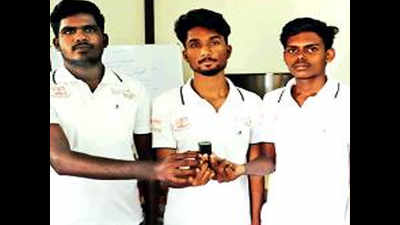- News
- City News
- trichy News
- NASA to launch Karur college students’ TD satellite
Trending
This story is from October 15, 2020
NASA to launch Karur college students’ TD satellite
Three college students from Karur district have won a global engineering design competition for their technology demonstrator satellite (TDS) that will be launched by National Aeronautics and Space Administration (NASA) next year as part of its ‘Cubes for Space’ programme.

Adnaan M, Arun V and M Kesavan won a global engineering design competition for their technology demonstrator satellite
TRICHY: Three college students from Karur district have won a global engineering design competition for their technology demonstrator satellite (TDS) that will be launched by National Aeronautics and Space Administration (NASA) next year as part of its ‘Cubes for Space’ programme.
A partner firm of NASA organises the programme for students across the world to propose experiments to launch into space or a near-space environment.Adnaan M and Arun V of the physics department of government arts college, Karur, along with M Kesavan of SNS engineering college, Coimbatore, decided to conduct research on graphene, which is the finest part of carbon.
The students’ team was among 80 teams selected from among 20,000-odd participants from across 72 countries. The team has built a 3cm cube satellite, claimed to be one of the world’s smallest, weighing 64 grams using reinforced graphene polymer. “Graphene being 100 times stronger than metal and much lighter in weight, we decided to experiment if it can be used for making aerospace vehicles,” said Adnaan, a second year BSc Physics student.
Their idea was recognised by NASA and the satellite made at a cost of Rs 1.35 lakh approved to be launched in June next year. Chennai-based Space Kidz India (SKI), an organization encouraging space research for students, had helped them develop the TDS. The satellite structure is made of reinforced graphene polymer which has been implanted with 13 censors, says Kesavan.
Adnaan and Kesavan, being classmates in class XII, had made an unsuccessful attempt for the Cubes for Space’ programme. “Learning from our mistakes and guidance from Space Kidz India helped us succeed in our second attempt,” they said.
A partner firm of NASA organises the programme for students across the world to propose experiments to launch into space or a near-space environment.Adnaan M and Arun V of the physics department of government arts college, Karur, along with M Kesavan of SNS engineering college, Coimbatore, decided to conduct research on graphene, which is the finest part of carbon.
The students’ team was among 80 teams selected from among 20,000-odd participants from across 72 countries. The team has built a 3cm cube satellite, claimed to be one of the world’s smallest, weighing 64 grams using reinforced graphene polymer. “Graphene being 100 times stronger than metal and much lighter in weight, we decided to experiment if it can be used for making aerospace vehicles,” said Adnaan, a second year BSc Physics student.
Their idea was recognised by NASA and the satellite made at a cost of Rs 1.35 lakh approved to be launched in June next year. Chennai-based Space Kidz India (SKI), an organization encouraging space research for students, had helped them develop the TDS. The satellite structure is made of reinforced graphene polymer which has been implanted with 13 censors, says Kesavan.
“The censors will help us calculate 20 parameters like temperature, humidity, UV value of reinforced graphene polymer and its effect in outer space at a distance of 120 km from earth surface,” he said. It has its own radio frequency communication to transmit and receive signal from earth to outer space. It has solar cells embedded on top of the TDS for power requirement.
Adnaan and Kesavan, being classmates in class XII, had made an unsuccessful attempt for the Cubes for Space’ programme. “Learning from our mistakes and guidance from Space Kidz India helped us succeed in our second attempt,” they said.
End of Article
FOLLOW US ON SOCIAL MEDIA











